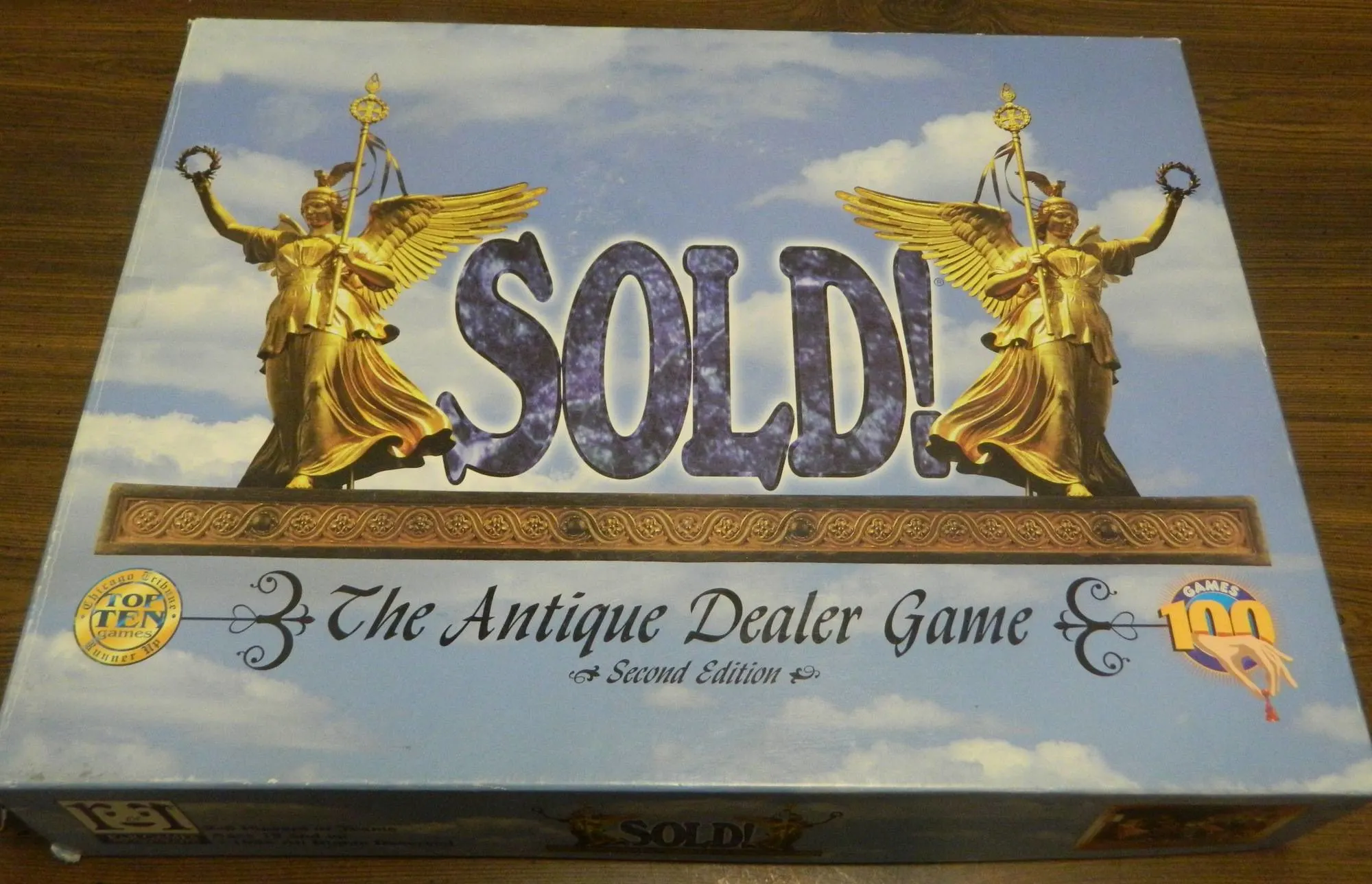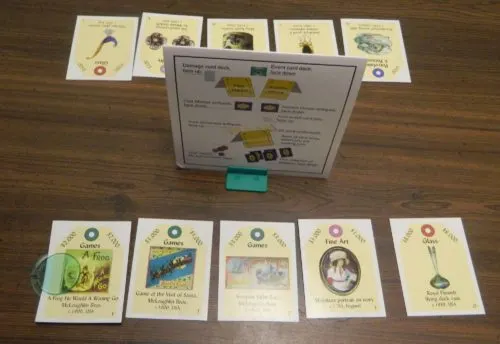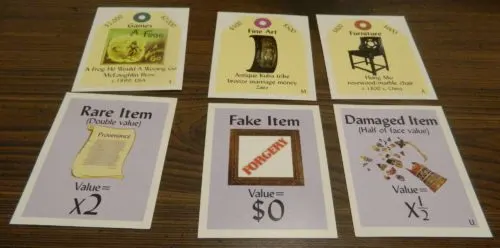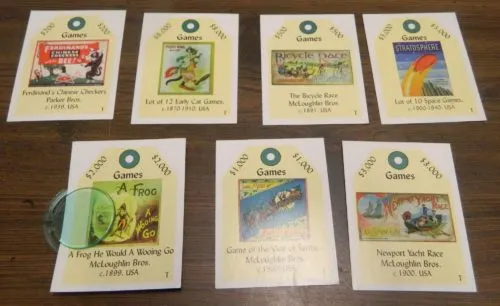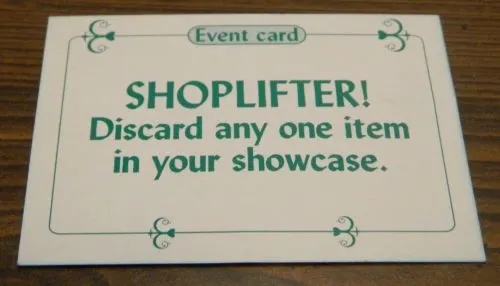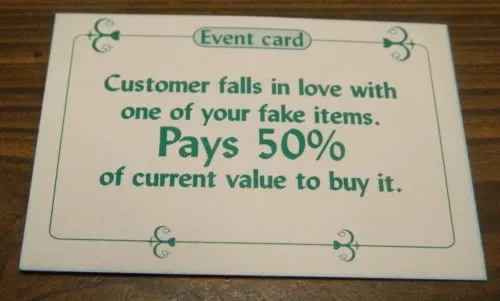R&R Games is a board game publisher that I feel has always been a little underrated. The company has made quite a few good to great games in the past and yet it never gets mentioned among the best board game publishers. Here at Geeky Hobbies we have looked at Pluckin’ Pairs, Plunder, and Time’s Up. Since R&R Games has been in business for over 20 years I was curious how good some of their older games were as some board game publishers earlier games are sometimes kind of hit or miss. Well today I am looking at Sold! The Antique Dealer Game which was released back in 1997 making it the third game released by R&R Games. Before I played Sold! The Antique Dealer Game I had pretty high expectations as I have enjoyed the other R&R Games that I have played, I generally love set collecting games, and the theme of being an antique dealer is a great idea for a board game. Sold! The Antique Dealer Game has some interesting ideas that could have lead to a good game if they weren’t a little before their time and left a little unpolished.
How to Play Sold! The Antique Dealer Game
Setup
- Shuffle the event cards and place the deck face down in the center of the table.
- Deal one shop card to each player. If there are less than six players, place the rest of the shops in the middle of the table. Place the flea market and auction house cards in the middle of the table as well.
- Separate the damaged item cards from the rest of the Sold! cards. Add eight of the damaged item cards to the sold! cards and shuffle the cards. Place the other damaged item cards face up on the table.
- Deal out the sold! cards face down as follows: 25 cards to the flea market, 10 cards to each shop including the shops not controlled by a player, the rest of the cards are placed in front of the auction house.
- Each player receives the following money from the bank: 1-$5,000, 3-$1,000, 3-$500, 4-$100, and 2-$50.
- Each player looks at the cards dealt to their shop. If a player is dealt any of the special value cards (rare item, fake item, damaged item) they will attach them to one of the item cards that they received without letting the other players see what the card is. The player then draws cards from the auction house equal to the number of special value cards that they were dealt. When adding a special value card to an item card the following rules must be followed:
- You can either add a rare or fake card to an item, not both.
- Only one damaged item card can be placed on each item. A damaged item card can be added to an item that also has a rare or fake card attached to it.
- Once a special value card is attached to an item it cannot be removed except for the damaged item card which can be removed if the item is repaired (see below).
- All of the players will then choose five of their cards to place face up in front of their store (referred to as your showcase) while the other five items are placed face down behind your shop (referred to as your private collection).
- The players roll the die. Whoever rolls highest gets to start the game. Play will then proceed clockwise.
Playing the Game
A game of Sold! The Antique Dealer Game consists of eight rounds. A round consists of each player taking one turn. A player’s turn consists of four steps:
- Take an event card and follow its’ directions.
- Repair one or more items at one of the shops.
- Visit one shop, the flea market, or the auction house.
- Redistribute the cards between your showcase and private collection.
Before explaining how the rest of the game is played, a couple terms have to be defined.
- The face value of an item is the number printed on the item card.
- The current value of an item is the number printed on the item card plus the effects of any special value cards attached to it and value added from a collection multiplier (see below).
- Fake items are worth nothing.
- Rare items are worth either two or three times their face value.
- Damaged items are worth half their face value. An item can never be worth less than $50 though so a damaged $50 item is still worth $50.
- When players acquire a certain number of items of the same type, a collection multiplier is added to every item that is part of the collection. An item with a collection multiplayer can be sold as the face value times the multiplier. The multiplier is calculated based on the number of items the player currently controls:
- 1-3 items: 1x
- 4-6 items: 2x
- 7-9 items: 3x
- 10-12 items: 4x
- 13-15 items: 5x
- 16-18 items: 6x
- 19-20 items: 7x
Event Cards
A player begins their turn by taking the top card from the event deck and placing it face up in front of their shop. They read the card out loud and take the appropriate action. If applicable, the card’s ability stays in effect for the entire round until the player’s next turn when a new event card is drawn which will cover up the previous event card. Some special event card types are as follows:
Tourists/Customer: The player who drew the card can sell items immediately to the bank depending on what the card says. The player receives the cash from the bank and discards the items that they sold.
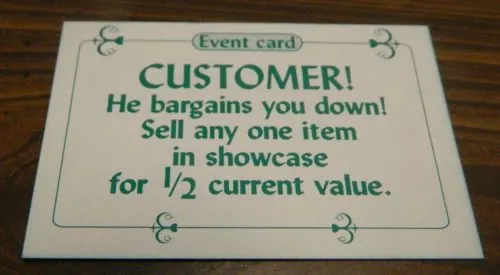
The player who drew this card has to sell one of the items in their showcase for half of its current value.
Collector Of: All of the players will compare the number of items they have in their showcase that match the category of items listed on the card. The player who has the most items of that category will immediately sell all of them to the bank for their current value and will then discard the item cards. If there is a tie for the most of an item, the tied player with the highest total value for that type of item will sell their items.
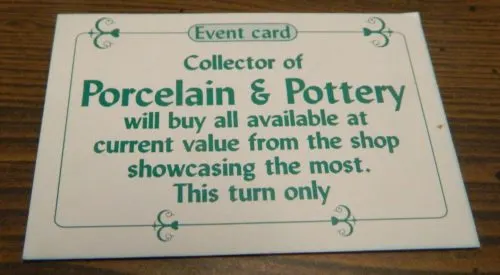
The player who has the most porcelain and pottery in their shop will get to sell it to the bank for its current value.
Shoplifter: The player who drew the card has to immediately discard one of their cards and receives no money for the item.
Inheritance: The player who drew the card gets to take the top card from either the flea market or auction house pile for free.
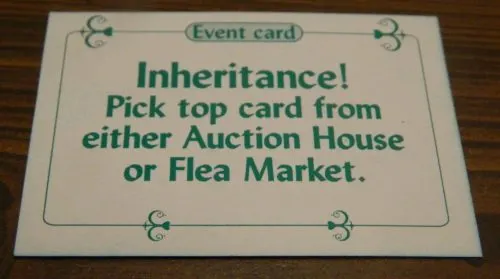
The player who drew this card gets to take the top card from either the flea market or auction house deck for free.
Competitior’s: The player who draws this card cannot charge more than half the current value for any of their items if another player wants to purchase them on their turn.
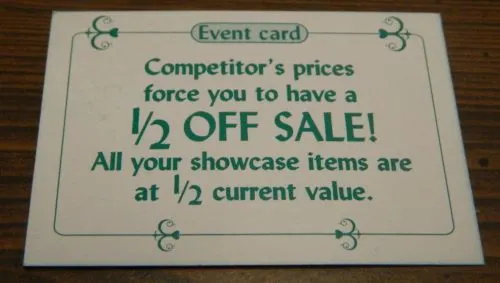
The player who drew this card has to sell their showcase items to other players at a maximum of 50% of their current value.
Customer Falls in Love With One of Your Fake Items: If you have a fake item you can sell it to the bank for half of its face value.
Estate Sale: The player who draws the card gets to look at the top three cards from either the flea market or auction house. They will have the opportunity to buy one of the items for 50% of its current value. The other two cards are put on the bottom of the corresponding deck.
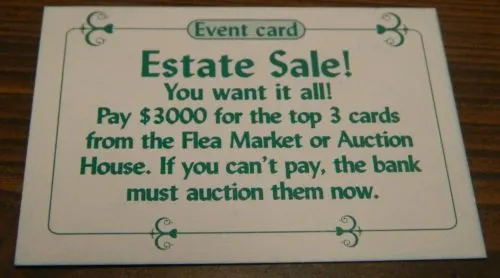
The player who draws this card draws the top three cards from either the flea market or auction house and pays $3,000 for it.
Repairing Items
The second step that a player can take on their turn is to get one or more of their damaged items repaired. To have a damaged item repaired, it must be taken to a shop that specializes in the type of item that you want fixed. For example for a piece of furniture to be fixed, it must be taken to the furniture store. If a player has multiple items of one type that need to be fixed, they can fix all of those items on the same turn.
To fix an item the player will have to pay a portion of the item’s face value. If the item is of the type of your own shop, you can fix the item for free. If the appropriate store is not controlled by any of the players, you will pay the bank 50% of the face value in order to fix the item. If another player owns the shop you will have to negotiate with them to fix the item. The most the player can charge to fix the item is 100% of the item’s face value. When an item has been fixed, the damaged item card is placed with the rest of the damaged item cards not currently in use.
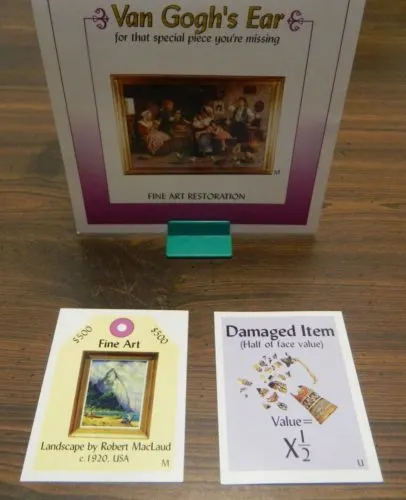
This player has taken their damaged fine art piece to the art store in order to get it fixed. If it is their own store, it will cost nothing to fix. If it is an unmanned store it will cost $250 to fix the item. If the store belongs to one of the other players they can charge up to $500.
Purchasing Items
A player can visit one shop on their turn in order to purchase items for their shop. How a player purchases items depends on which shop they visit.
Another Player’s Shop
If a player visits another player’s shop they have the ability to buy or trade for any item in that shop. The shop owner cannot refuse to sell an item in their storefront but can refuse to sell any items they have in their private collection. The shop owner can charge the player visiting their shop up to the current value of any item in their showcase. If the player has three or more items of one type in their showcase, they can add the collection multiplier to the price of all of the items of that collection. The store owner can charge whatever price they want for items in their private collection and could even deny letting the other player see what they have in their private collection. If the buyer is not satisfied with a price they can negotiate with the store owner hoping that they reduce the price.
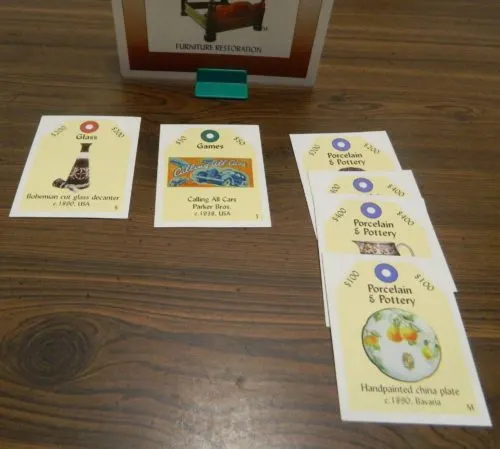
This player has decided to visit a store controlled by one of the other players. The player who owns the store can charge up to $200 for the glass, $50 for the game, and two times the face value for any of the porcelain & pottery pieces.
Unmanned Shop
If a player visits one of the shops that aren’t controlled by one of the other players, they can purchase up to three of the items from that shop. They choose how many of the items they want and will pay 50% of the current value for each item. If one of the cards flipped over is a special value card, another item card is drawn and the special value card is attached to it. If a player has enough money to buy an item they will have to even if it is an item that they don’t really want. If the player cannot afford the item, the item is placed face up in front of the store and any player can buy it on their turn for full current value. Once an unmanned shop runs out of items, players can no longer visit the shop to buy items.
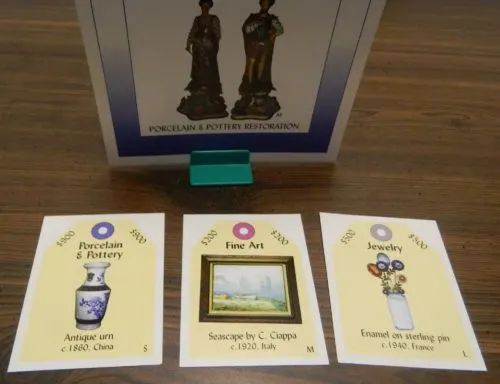
This player has decided to purchase three items from an unmanned store. They will have to pay $450 for the Porcelain & Pottery, $100 for the fine art, and $250 for the jewelry.
Flea Market
When a player visits the flea market they can purchase up to three items. Flip over the top card and roll the die. The amount you will pay for the item is equal to the item’s face value times what is written on the auction house for the number you rolled. If you rolled a 2, 4 or 6 you also have to add a damaged item card to the item you purchased. If you can afford to purchase the item, you must purchase it. The player can then choose to purchase another item (up to a maximum of three items). If a player cannot afford an item it remains face up in front of the flea market. Other players can use this card for one of their items when they visit the flea market.
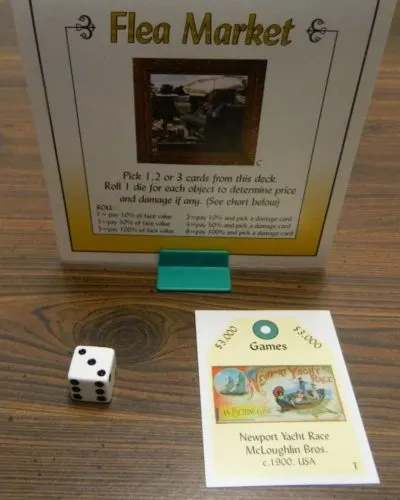
This player flipped over a $3,000 game at the flea market. They rolled the dice and rolled a three. The player will have to pay 50% of the face value ($1,500) for the game.
Auction House
If a player visits the auction house they take two actions. They will begin by choosing which of their items (showcase and/or private collection) that they would like to auction off. The player will announce the starting bid which can be anything they want as long as it is a multiple of $50. The player can either hold an open auction or a silent auction. For an open auction players keep raising the bid until someone bids higher than the rest of the players. If the bid is higher than the minimum bid, the player has to sell the item(s) to the highest bidder. For a silent auction all of the players submit their bids to the auctioneer in private with the highest bidder getting the item. All money paid for the item(s) is given to the player running the auction.
The player will then take the top three cards from the auction house deck. The player will choose to either auction all of the items together or to separate them into two or three lots. The minimum bid in these auctions is 50% of the item’s current value. If someone bids at least the minimum bid, the highest bidder will pay their bid to the bank and take the corresponding card. If a card(s) is not bid on it is put on the bottom of the auction house deck.
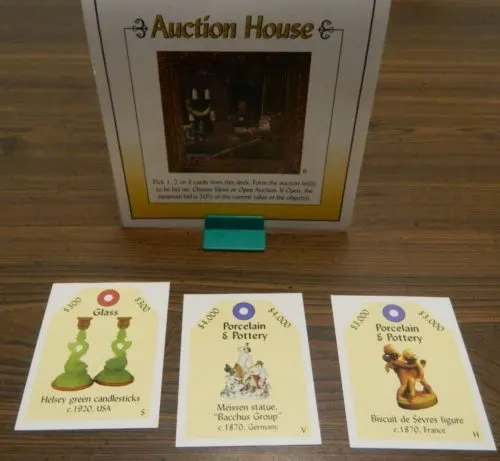
These three item cards were taken from the auction house deck. The player who visited the auction house can choose between auctioning them off separately or putting them into one or two lots.
Rearranging Your Store
At the end of a player’s turn they have the opportunity to move items between their showcase and private collection. The only rule around moving items is that a player needs to have at least five items in their showcase. If the player has less than five items total, all of their items must be in their showcase.
After rearranging your store, the player to your left takes their turn.
Winning the Game
The game ends when all eight rounds have been played. Players calculate their assets by counting up their cash-on-hand and adding in the value of the items that they still own. Sort all of your items by their type. For item types where you have only one to three items, add their current values to your cash total. Damaged items are worth their current value but do not count when determining the value of a collection (see below). Fake items have no value and do not count towards a collection.
For each collection that has four or more items (that aren’t damaged or fake) you will add up their current values and round to the nearest $1,000. Open up your shop card and find that value on the chart. Move right from that number until you get to the total that corresponds to how many items of that type you have. This is the value of the collection.
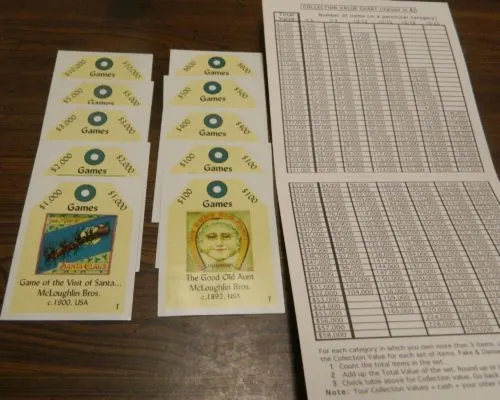
This player has acquired games worth $22,700. The total is rounded up to $23,000. Since the player has ten games they will move across the $23,000 line until they get to the 10-12 column. This collection is worth $92,000.
The players compare their total assets. The player who has the most assets wins the game.
My Thoughts on Sold! The Antique Dealer Game
As I thought about what to write about in this review of Sold! The Antique Dealer Game, one thing continually crossed my mind. I couldn’t get the thought of what could have been out of my head. Sold! The Antique Dealer Game had a lot of promise/potential, especially for a game from 1997, but it feels like a classic case of a game that was before its time. The game has a great framework but it just feels like a couple things are missing. This fact turns a promising game into a pretty boring experience.
Before I get into what I think could have been improved, I want to talk about what I liked about the game. As I already mentioned I love the game’s theme. As I enjoy going to rummage sales and thrift stores, the idea of buying and selling antiques really appealed to me. I think the theme works well with the gameplay for a couple reasons. I think it was clever for the game to have several different ways to acquire items from stores, the flea market, and even auctions. I kind of wish there was a thrift store/garage sale mechanic but it probably would have been overpowered so I can see why it was not included. I also think the theme works pretty well with the game’s underlying set collection mechanics. As antique sellers generally have areas that they specialize in, it makes sense that the goal is to acquire items of the same type. The final thing I loved about the theme is that the game actually put in the effort to include real antiques in the game. Being a board game collector myself I especially liked seeing the really old board games pictured on some of the cards.
The other thing that I really liked about Sold! The Antique Dealer Game is that it feels like it has a really strong foundation. While I have played better set collection games, I think the framework works pretty well in Sold! The Antique Dealer Game. Most of the strategy in the game revolves around acquiring as many items as you can of a couple different types of items as the collection multiplier is the easiest way to add value to your assets. If you can get a lot of items of the same type their value grows quickly. It is actually quite satisfying being able to acquire a large collection of one type of item.
I also liked that the game gives players several different ways to acquire items. While I don’t think all of the ways to acquire items are equal, I appreciate the variety that they bring to the game. In particular I think the best way to acquire items is to buy them from unmanned stores. The items from these stores went quickly as they are a good deal since you purchase them at 50% of their value. The flea market is interesting as it adds a risk/reward mechanic as you could get a really good deal or you could end up paying full price and still get a damaged item. While I can see the value of the auction house, it didn’t really work with our group. Most of the time it didn’t really pay to auction your own items since sellers wanted to get full value for their items while the other players wanted to get a deal which lead to items not really selling. Auctioning up items from the auction house didn’t really work either because no player would let a player get a deal on an item especially if they knew the other player was collecting those items.
I think the two mechanics that worked the least though were getting repairs from other players and trying to buy items from other players’ shops. Maybe it is just my group but the players are always stubborn with these type of mechanics. The player selling items/offering repairs refused to ever give the other player any deals. They would ask for at least 50% to fix any item which meant a player would gain no value by repairing an item. When selling items players always started at the maximum price and rarely budged from that price. The only time that players bought items from other stores is when there were items that they were collecting as adding them to their collection was worth paying full price. Sold! The Antique Dealer Game is one of those games that is going to hit some bumps if all of the players are stubborn and refuse to deal.
While I had some fun playing Sold! The Antique Dealer Game, the biggest problem I had with the game is that there doesn’t really appear to be a set strategy that you should pursue outside of trying to collect items of the same type. The game’s instructions make a big deal about the strategy between putting items in your showcase versus your private collection. At first I thought there was a hidden strategy behind the decision but at the end of the day there wasn’t much strategy to this decision. There are definitely times where it is best to keep your collections and high priced items in your showcase but there are other times you want to keep them in your private collection.
Generally I would say you should keep your high priced items and collections in your private collection. Keeping them in your private collection protects you when harmful event cards are drawn and prevents the other players from buying them from you. At the beginning of the game I decided to go with this strategy but you soon realize that solely pursuing this strategy introduces its own problems. The biggest problem is that all of the items you store in your private collection is money that you have sunk into items that you won’t get out until the end of the game. If you don’t put any good things up for sale you will quickly run out of money and then you can’t buy anymore items. The other reason why you might want to consider putting your valuable items in your showcase is the fact that there are quite a few event cards that can actually really help you if you have valuable items in your showcase. Sometimes customers pay twice the value for items and could buy your entire collection for more than it is worth. This actually happened in our game as one player was able to sell their large collection for more than its value earning them more money from that one transaction than some players earned in the entire game.
While I tried to find the hidden strategy I just couldn’t find it. What you should do on any given turn seems to come down to luck. I think this is the case due to the fact that it feels like the event cards decide who ultimately wins the game. What event card you draw at the beginning of your turn seems to have just as much if not more impact than whatever else you do the rest of your turn. Sometimes you will draw cards that you can’t even use or cards that help the other players. Meanwhile other players will draw cards that let them sell items for more than they are worth. There are even the occasional event cards that can either win or lose you the game. For a game that has the feeling of a strategic game, it is such a shame that so much in the game is determined by random card draw.
The over reliance on luck and the fact that there doesn’t seem to be a lot of underlying strategy to the game leads to Sold! The Antique Dealer Game being kind of boring. While I wouldn’t say that any of the mechanics in Sold! The Antique Dealer Game are overly difficult, for some reason the game feels like it is more complicated than it needed to be. This makes the game start kind of slow as the players try to grasp all of the different mechanics. Basically the game’s mechanics don’t feel very polished as I think the game could have used some more streamlining. This is kind of a shame because this feels like it was due to the time period when it was created. If the game was created today I think the game would have been streamlined more which would have really helped the game. When players are more familiar with the mechanics the game moves quicker and is more enjoyable but by that time most players will already be bored.
Like so many other things with Sold! The Antique Dealer Game I think the components could have been better. As I already mentioned I really liked how the game decided to use real antiques on the cards. The problem is that outside of that I thought the components could have been a lot better. The cardstock is kind of thin making the cards prone to creases. I think the thing I disliked the most is the fact that the game decided to use coins for the money in the game. I have never understood games that decide to use coins for money. They might thematically add to a game and I don’t mind that when you don’t regularly use the coins to buy and sell things. I just think it is a pain to use coins in games where money is regularly changing especially since it would have been much easier to just use paper money.
Should You Buy Sold! The Antique Dealer Game?
At the end of the day Sold! The Antique Dealer Game is a game of interesting ideas that don’t work right. I had high hopes for the game as it actually has a pretty good framework. I love the game’s theme, the set collecting mechanics could have been really good, and I even liked how the game gives you multiple ways to buy items. The problem is that the game never capitalizes on these ideas. It feels like there really is no strategy to the game outside of collecting items of the same type as most of your fate in the game is decided by what event cards are drawn. The game also lacks polish which is a shame since if the game was created today I think it would have been more streamlined which would have made it a better game. This lack of polish leads Sold! The Antique Dealer Game to be more complicated than it needed to be which leads to the game being kind of boring.
It is a real shame that Sold! The Antique Dealer Game couldn’t live up to its potential. I could see what the game could have been if it had the knowledge of what has been learned from board game design over the last 20 years. This is really evident in the fact that we have played other similar set collection auction style games (Going Going Gone (2013) for example) that have been created more recently which are considerably better. Sold! The Antique Dealer Game is not a terrible game but there are better options out there as well. If you already own one of these similar games I don’t really see a reason to pick up Sold! The Antique Dealer Game. If you can find the game for cheap though and don’t mind trying to tweak the game with some house rules, it may be worth picking up.
If you would like to purchase Sold! The Antique Dealer Game you can find it online: Amazon, eBay

